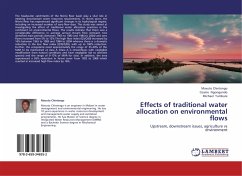
Effects of traditional water allocation on environmental flows
Upstream, downstream issues, agriculture vs environment
Versandkostenfrei!
Versandfertig in 6-10 Tagen
33,99 €
inkl. MwSt.

PAYBACK Punkte
17 °P sammeln!
The headwater catchments of the Rivirivi River basin play a vital role in meeting downstream water resources requirements. In recent years, the Rivirivi River has experienced significant changes in its hydrological regime, including an increased number of zero-flow days. This study was aimed at investigating the effect of traditional water allocation practices in the catchment on environmental flows. The results indicate that there was a considerable difference in average annual stream flow between two identified main periods (between 1963 to 1983 and 1984 to 2004) and zero flows increased fro...
The headwater catchments of the Rivirivi River basin play a vital role in meeting downstream water resources requirements. In recent years, the Rivirivi River has experienced significant changes in its hydrological regime, including an increased number of zero-flow days. This study was aimed at investigating the effect of traditional water allocation practices in the catchment on environmental flows. The results indicate that there was a considerable difference in average annual stream flow between two identified main periods (between 1963 to 1983 and 1984 to 2004) and zero flows increased from 5% to 12% The high flow index (Q5/Q50) increased by 16% between 1963 to 1983 and 1984 to 2004 whereas there is a dramatic reduction in the low flow index (Q95/Q50), with up to 100% reduction. Further, the ecosystems need approximately the range of 35 40% of the MAR to be maintained at class A (Class A is streamflows with negligible modification from natural conditions and have negligible risk to sensitive species) and the range of 9 13% of MAR for class. In addition, the area experienced a 65% reduction in forest cover from 1992 to 2008 which resulted in increased high flow index by 16%.


